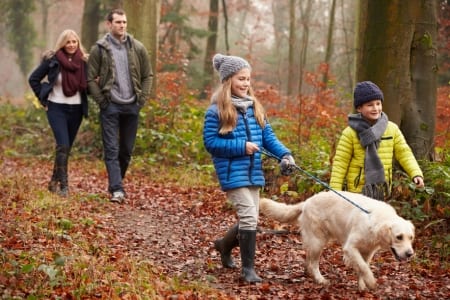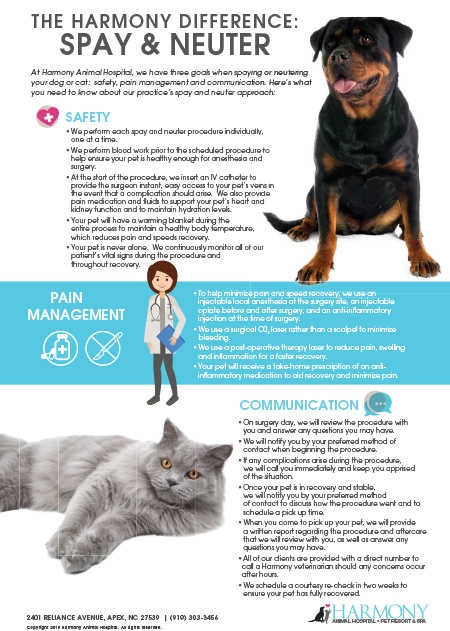Spay and Neuter – Dogs
Neutering Male Dogs
The general recommendation is that a male dog can be neutered as he reaches sexual maturity, starting at 6 months of age. However, this recommendation has never had anything to do with the health of your pet. Rather, it is grounded in population control and curbing “Bad Boy” behaviors, such as:
- Urine marking
- Inter-dog aggression (aggression towards other dogs)
- Wandering
- Fleeing
- Mounting
For male dogs with owners who consistently supervise them and keep them indoors, we recommend waiting until 12-24 months of age before neutering, for the following benefits:
- Testosterone helps close your dog’s growth plates. If your male dog is neutered too young, the growth plates may take longer to close, making his bones grow longer and resulting in him being larger overall than he normally would have been. This can cause orthopedic problems such as cranial cruciate ligament rupture. This is of particular concern for larger dog breeds.
- Muscle Maturity helps create a lean physique. Waiting to neuter until 12-24 months allows your dog to reach full muscle maturity and develop a lean physique.
- Male hormones are more likely to increase your pet’s energy and vigor. Though this may not always be perceived as a good thing, if you have a specific purpose in mind for training your dog, you may want to consider waiting longer before neutering him. For instance, if you are raising a search and rescue animal, waiting until 24 months to neuter will allow your dog to develop the drive necessary to succeed at challenging tasks and training. However, while some dogs will slow down a bit after neutering, don’t expect neutering to completely calm your dog if he is more on the hyperactive side.
While waiting may not be practical or feasible for all pet owners, each month we can extend beyond the 6-month sexual maturity threshold is better for the overall health and well-being of your pet. However, we’ll work with you to determine the appropriate time based on yours and your pet’s lifestyle, and electing to have the neutering procedure done when the dog reaches sexual maturity at around 6 months of age is always an option.
The Intact Option for Male Dogs
Some pet owners choose not to neuter their male dogs. In some breeds, choosing not to neuter can reduce your dog’s risk of cancer. And, in general, intact male dogs will be muscular and lean as a result of their natural hormones regulating body growth and development. However, the health and behavioral risks associated with this option could outweigh the positives as your pet ages.
Downsides to the intact option include:
- Inter-dog aggression. Intact dogs tend to behave more aggressively toward other dogs
- Increased urine marking behavior. Intact male dogs “mark their territory” more frequently than neutered dogs
- Roaming and wandering in search of female dogs. If you have an outdoor male dog, he may disappear or try to escape in order to find a mate
- Unwanted breeding. Even the most vigilant pet owners may have difficulty keeping an intact dog from breeding because they are extremely good at finding females with which to mate
- Increased risk of testicular cancer. Intact dogs may develop this serious disease, and testicular cancer requires aggressive treatment, such as surgery and chemotherapy. If not caught early, testicular cancer can be a fatal
- Benign hyperplasia of the prostate. As they age, intact dogs have difficulty urinating and defecating
- Higher risk of prostatic abscesses and cysts. Unneutered dogs are more likely to develop pus-filled abscesses and painful cysts in their prostates
- Development of unsightly thickening of tissue around the anus
- Increased risk of a Perianal Hernia around the anus as the dog ages. This type of hernia is very painful, unsightly, and potentially life threatening. It requires extremely challenging surgery with a high rate of complication
- Increased risk of Perianal Tumors. Older, unneutered dogs are at higher risk of developing perianal tumors, which can be benign adenomas or very aggressive malignant adenocarcinomas, which are life-threatening. Both types are uncomfortable and unsightly, requiring surgical excision to help eliminate pain and reduce the chances of permanent complications arising due to the location of these tumors.
- Risk of testicular torsion. Testicular torsion is a painful condition that occurs when the spermatic cord twists, causing loss of blood flow to the testicle. Testicular torsion is a medical emergency and requires neutering.
Neutering Breeding Candidates and Dogs with Cryptorchidism
Dogs that are kept intact for breeding purposes should be neutered at the end of their breeding career to reduce the risk of the diseases and conditions mentioned above. Generally, intact dogs start to develop problems between 7 to 9 years of age, and we recommend neutering breeding candidates around 6 years of age in order to reduce the dog’s health risks.
In the case of dogs with cryptorchidism, a condition that occurs when one or both of the testicles fail to descend into the scrotum, neutering is absolutely essential. If a male dog with cryptorchidism is not neutered, he is at great risk for cancer, life-threatening anemia and testicular torsion. Dogs with cryptorchidism are not good breeding candidates because they can pass the condition on to their male puppies.

Spaying Female Dogs
While female hormones do not play as large a role in closing the growth plates as male hormones do, that is not the reason why we generally recommend spaying female dogs at an earlier age than we do neutering male dogs. The more important factors are reducing the risk of mammary cancer and helping owners avoid having to deal with the inconvenience of caring for a female pet in heat.
Here are some of the benefits of getting your female dog spayed before the onset of in-heat cycles, which is typically between 6 and 8 months of age:
- Reduced risk of mammary cancer. Spaying before the first heat reduces your female dog’s risk of mammary cancer by 85%. With each in-heat cycle, a female dog’s risk for mammary cancer increases.
- Convenience. Female dogs discharge blood while in heat. Each dog differs in this respect, but the bloody discharge can be heavy and may last for 7-10 days, and it can be extremely difficult for pet owners to manage.
- Reduced risk of pyometra. Pyometra is a life-threatening uterine infection, and spaying your female dog eliminates her risk for developing this dangerous illness. If a female dog suffers from pyometra, the only treatment is an immediate spay procedure.
- No false pregnancies. Female dogs who have not been spayed sometimes have false pregnancies that can be challenging to manage. False pregnancies cause female dogs to become restless, agitated and protective and show nesting behavior by hiding in unusual places or collecting things. They even make milk, though there are no puppies.
When to Wait One Heat Cycle Before Spaying Your Female Dog
Sometimes it’s advisable to allow a female dog to come into heat for one cycle before getting her spayed. This is particularly true for female dogs with a hooded or juvenile vulva. A hooded vulva is characterized by a fold of skin over the dog’s genitals, and it can cause inflammation, loss of hair, discoloration, and other issues in the genital and urinary area.
Hooded/juvenile vulva corrects itself more than 50% of the time after a female dog goes through her first heat cycle, which is why some pet owners choose to wait before spaying their pet. At Harmony Animal Hospital, we can facilitate a spay procedure before or after the first heat cycle. If you don’t wish to wait until the end of your dog’s first heat, the folded hood of skin can be corrected surgically with a procedure called episioplasty that can be done at the time of your dog’s spay procedure.
Effect of Heat Cycles on Bone Cancer (Osteosarcoma)
In certain breeds, such as Rottweilers, allowing for multiple heat cycles reduces the risk of the dog developing osteosarcoma (bone cancer). Even though waiting to spay your female dog may reduce her bone cancer risk, this benefit is not outweighed by the risk of mammary cancer, which increases every time your dog goes into heat. Osteosarcoma and mammary cancer are both serious and can be life-threatening, although bone cancer is likely to be more painful and more difficult to cure.



